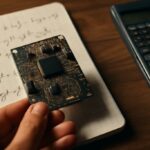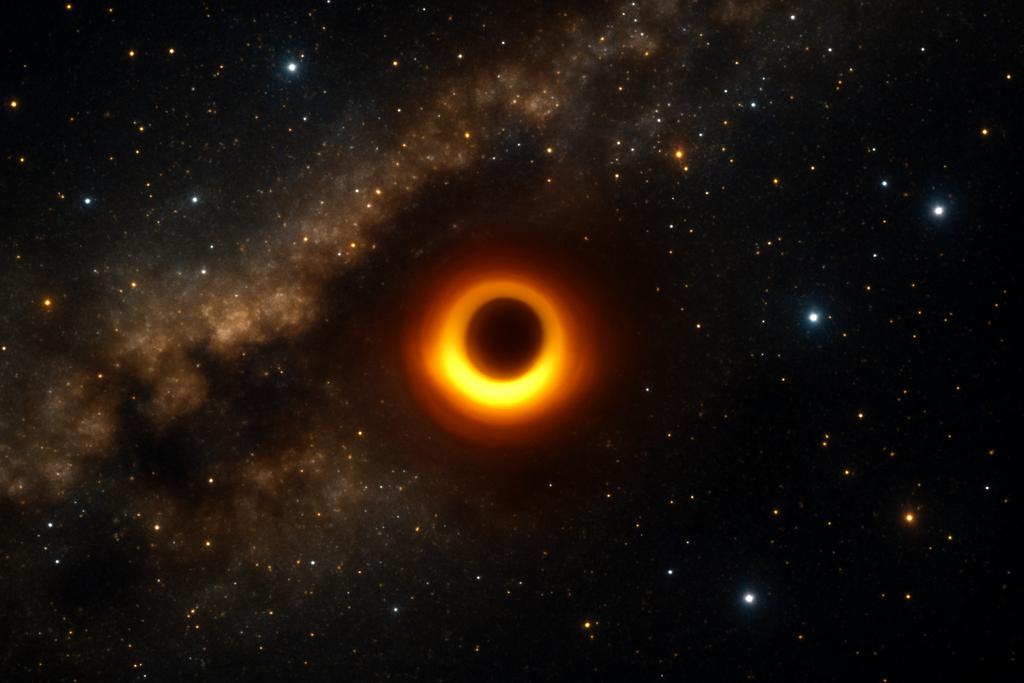In the very heart of our galaxy, a beacon named Sagittarius A* sits at the center of a swirling banquet of stars and gas. For decades, scientists have treated it as a supermassive black hole, a gravitational furnace where Einstein’s ideas about space and time are pushed to the limit. The new work from a team led by Nicolas Aimar and colleagues asks a provocative question: what if Sgr A* isn’t a black hole at all, but an exotic compact object that looks and behaves like one in many ways—yet harbor a different inner life? The study, authored by researchers from CENTRA at the University of Porto, IST in Lisbon, and the Institute of Physics at the University of Tartu, uses the object’s polarized near-infrared flares as a diagnostic tool to test the space-time around it. In short, they’re turning the center of the Milky Way into a laboratory for fundamental physics.
The paper signals a shift in how we search for new physics in strong gravity. Rather than hunting for distant, theoretical curiosities, the authors pull ideas into a data-rich, near-term horizon: polarization measurements from GRAVITY, the European Southern Observatory instrument that can track tiny motions of light at the level of micro-arcseconds. If Sgr A* is an exotic compact object, its shadow and the way light winds around it should leave telltale polarization fingerprints, especially when a bright “hot spot” flickers in the accretion flow and whizzes around the object. The researchers openly acknowledge: this is not a slam-dunk claim yet. But it is a careful, map-making step toward testing what space-time might actually allow in the most extreme gravity we can observe in practice.
Polarization as a Probe of Space-Time
Light carries more than brightness; it carries orientation. In astronomy, polarization is the orientation of the light’s electric field, described by the Stokes parameters Q and U for linear polarization and V for circular polarization. When light travels through the warped spacetime near a compact object, its path bends and its polarization vector can swing in subtle ways. Those swings aren’t random quirks of the gas; they encode how gravity itself is shaping the journey of photons. The authors lean on this principle, using polarization as a sharper probe than brightness alone to distinguish different space-time geometries.
GRAVITY, the interferometric powerhouse on the Very Large Telescope Interferometer (VLTI), has already demonstrated that it can measure the tiny astrometric wobbles of flares near Sgr A*. Now, the team extends the idea: what if we also track how the flare’s polarization evolves over the orbit? By monitoring both where the light lands and how its polarization twists as the hot spot circles the object, we can test whether the surrounding space-time behaves like Schwarzschild (the non-rotating black hole solution) or something else. The approach hinges on simulated data, but it’s anchored in the best available measurements and a clear hypothesis: exotic compact objects—if they exist—will imprint distinctive plunge-through images or additional light paths that alter polarization in observable ways.
The modeling choices are conservative: a vertical magnetic field, a non-thermal electron distribution, and a hot spot emitting synchrotron radiation. The authors use a polarized ray-tracing code called GYOTO to predict the time evolution of the flare’s total flux and its polarization signals, for eight metrics drawn from four families of static, spherically symmetric objects: Schwarzschild black holes and three ECO families—solitonic boson stars, relativistic perfect-fluid spheres, and gravastars. The key engineering move is to compare how well each metric fits simulated GRAVITY-like data, then judge whether any ECO model stands out strongly enough to claim a detection.
Exotic Compact Objects: Boson Stars, Gravastars, and Fluid Spheres
The paper surveys three broad ECO families, each offering a different route around the idea of a horizon and a central singularity. Boson stars are built from self-gravitating scalar fields; their compactness can reach up to ultra-compact regimes without collapsing into a singularity. The team focuses on solitonic boson stars, which can harbor bound photon orbits, a feature that tangles light paths in distinctive ways. The relativistic fluid sphere is a more “ordinary-looking” interior: a slice of isotropic, perfect-fluid matter that matches smoothly to Schwarzschild outside. Gravastars are the most exotic of the trio: an interior with a negative-pressure equation of state (p = −ρ) that mimics a black hole’s exterior but lacks an event horizon.
All three ECO families, in various incarnations, can mimic the external appearance of a black hole closely enough to satisfy existing imaging constraints, such as those from the Event Horizon Telescope. Yet they differ internally in how light threads through their interiors and how many bound photon orbits they support. A striking feature the authors highlight is the role of plunge-through images—light that threads around the compact object in a way that would be forbidden or at least distinct for a true Schwarzschild black hole. These plunge-through images contribute extra bright images and alter the polarization properties in time, offering a potential observational handle to tell ECOs from ordinary black holes.
In addition to the geometric differences, the authors keep the physics deliberately tractable. They model a single hot spot orbiting the object in the equatorial plane at the Schwarzschild-Keplerian velocity, and they assume a vertical magnetic field with a modest magnetization. The goal isn’t to capture every nuance of accretion physics but to isolate how the space-time portrait—the metric itself—prints itself on the polarization signal. If polarization measurements can tease apart these metrics, then astronomy gains a direct, empirical test of what kind of compact object sits at the center of our galaxy.
What the Study Found and Why It Matters
When the researchers run their simulations through the lens of current GRAVITY uncertainties, they find a sobering but hopeful picture. Among the eight metrics tested, most ECOs leave polarization signals that are too entangled with astrophysical parameters to yield a decisive preference. The Schwarzschild metric can be excluded in many cases if one assumes the ECO as the background, because the plunge-through polarization features tend to be at odds with the data, but the ECOs themselves largely resist clean discrimination from one another. The notable exception is a particular boson-star model (Boson Star 2), whose plunge-through images are unusually large and imprint a distinctive polarization footprint that can be distinguished from Schwarzschild with present uncertainties. In short, with current data, the center of the Milky Way can sometimes tell you it isn’t Schwarzschild, but it often can’t tell you which ECO it is.
The paper then maps out what improvements would change the game. If GRAVITY+ arrives with roughly seven times smaller flux uncertainties, or if the team can gather data with higher time resolution, the situation changes dramatically. In that enhanced regime, nearly all ECO metrics become detectable as distinct from Schwarzschild, and many can be differentiated from one another. The authors show a striking example: with a new, finer cadence (one-minute sampling rather than five minutes) and improved photometric precision, the polarization signatures diverge enough that Schwarzschild can be ruled out in most ECO cases, and specific ECO families sit clearly apart in the fit statistics. This is the moment when the galactic center’s light becomes a true stress test for gravity in the strong-field regime.
There’s a sharp caveat, though. The study’s hot-spot model is deliberately simple. Real flares likely involve complex time variability, evolving magnetic fields, and a host of radiative processes that could blur or mimic the metric signatures. The authors acknowledge that degeneracies between astrophysical parameters and space-time effects could dull the discriminating power. They also note that quiescent emission from Sgr A* plays a non-negligible role over longer timescales. Put bluntly: better instruments can give you better data, but better physics modeling is needed to prevent misinterpreting what the data are trying to tell you.
So what does all this mean for the big questions in physics? If GRAVITY+ delivers as promised, Sgr A* could become a laboratory for testing the very nature of horizons, information, and quantum gravity in a regime where theory has struggled to keep up with observation. If the data consistently favor ECO metrics over Schwarzschild, we might be staring at a real alternative to the black-hole picture—one that resembles a black hole from far away but reveals a very different inner architecture when probed with polarization and high-precision astrometry. If, on the other hand, Schwarzschild remains undefeated even in the face of high-precision polarization data, we gain a stronger empirical foothold for the classical black-hole paradigm and tighter constraints on exotic alternatives. Either outcome would reshape how we think about compact objects and the quantum-gravity tension that still haunts our theories.
Behind the numbers and the simulations lies a broader narrative: the universe keeps offering new ways to test its own rules. The study is a reminder that even in a region as well-studied as the center of our own Milky Way, nature can surprise us with hidden structures that only reveal themselves under the right observational conditions. The collaborators behind this work—Nicolas Aimar, João Luís Rosa, Hanna Liis Tamm, and Paulo Garcia—ground their investigation in the European scientific tradition of cross-institution collaboration. The team’s affiliation with CENTRA at the University of Porto, the Instituto Superior Técnico in Lisbon, and the Institute of Physics at the University of Tartu anchors the project in a network of researchers who bring together rigorous theory, sophisticated simulations, and state-of-the-art instrumentation. Their joint effort illustrates how modern astronomy blends astrophysical modeling with engineered measurement to pry open the darkest corners of gravity.
Lead researchers: Nicolas Aimar (CENTRA/IST, University of Porto and Lisbon), João Luís Rosa (Institute of Physics, University of Tartu), with co-authors Hanna Liis Tamm and Paulo Garcia. The work is grounded in the GRAVITY and GRAVITY+ era, leveraging sophisticated ray-tracing and polarization modeling to push at the edges of what we can learn from Sgr A* today.










